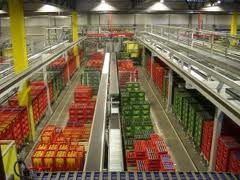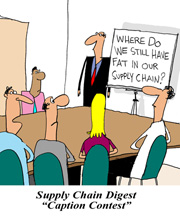 |
|
|
Featured Sponsor: KIVA Systems
|
 |
| |
Download New Case Study:
DJO Global Applies Lean Principles to
Medical Distribution
Using KIVA Automation

|
| |
|
|
|
|
|
 |
 |
|
| TUESDAY'S VIDEOCAST |
The Fast-Response Food & Beverage Supply Chain
Accelerating Response-Time and Visibility of Supply Chain Processes with Rugged Mobile Computing
All attendees will be entered into a drawing for one of two Motorola Rugged Enterprise Digital Assistants (EDA)!

Tuesday, October 25, 2011
 |
| |
| WEDNESDAY'S VIDEOCAST |
Building Next Generation Supply Chains for Discrete Manufacturers
Part 3 -- Driving Costs Out of Discrete Manufacturing Supply Chain Execution
SCDigest Editor Dan Gilmore Shares his Views, as He Switches Roles, and is Interviewed by RedPrairie's Tom Kozenski in the Unique Videocast

Wednesday, October 26, 2011

|
|
| NEW UPCOMING VIDEOCAST |
The What, Why and How of Vendor Scorecards
Part 2: Effectively Executing the Scorecarding Methodology
Featuring a Simulated Retailer-Vendor Scorecard Meeting - with SCDigest editor Dan Gilmore Playing the
Role of the Vendor!

Tuesday, November 15, 2011

|
|
| NEWS BITES |
This Week's Supply Chain News Bites
|
|
|
|
|
FEATURED WHITEPAPER
|
Whitepaper Available
From
Intelleflex


|
|
DOWNLOAD NEW CASE STUDY
FROM KIVA SYSTEMS |

Download New Case Study:
DJO Global Applies Lean Principles to
Medical Distribution Using Kiva Automation

|
NEW CARTOON CAPTION CONTEST
BEGINS THIS WEEK! |
October 18, 2011 Contest
|

See The Full-Sized Cartoon and
Send In Your Entry Today !
|
|
|
|
|
|
|
|
|
| |
|
|
| Q: |
A little change of pace this week, given the season -- What major league baseball team is second to the New York Yankees in terms of World Series championships? |
| A: |
Found at the Bottom of the Page |
|
|
|
|
| Can - and Should -Western Manufacturing be Saved Part 4? |
The world is still in some sort of great whirl, and looks like it is going to stay that way for a long while. Not very pleasant, is it?
Economics of course is at the heart of the issues from unemployment to European debt to the financial time bomb of the aging populations in most of the developed world.
With that out of my system, it's worth noting that it seems countries across the globe sees the path to salvation from this mess is to recharge their manufacturing sectors - even China.
| GILMORE SAYS: |
"The obvious question: if America does decide to rebuild its infrastructure, will we be doing it with steel made in China, not Pittsburgh or Middletown, OH or Gary, IN?."
WHAT DO YOU SAY?
Send us your
feedback here
|
Consider that just in the past couple of months:
In India, the government said that it will begin debating a National Manufacturing Policy that aims to raise the contribution of manufacturing in the country's GDP from 16% currently to 26% by 2025, saying this will create 100 million jobs in next 10 years.
In Australia, the country's Chamber of Commerce and Industry called for the government to reduce taxes and regulatory burdens to keep the country's manufacturers more competitive with the rest of the world. How serious is the challenge there? New start-ups in manufacturing in Australia have dropped from an average of about 700 each year over the past three years, to just 14 in the first six months of 2011. Wow.
In August, Luo Jun, CEO of the Asian Manufacturing Association, wrote that Chinese governments needed to make moves to open up lending to businesses, especially smaller manufacturers and those in the coastal areas such as Guangdong and Zhejiang provinces, to help them weather the storm until the domestic market picks up, among other measures, to counter growing weakness in its manufacturing sector.
There are similar efforts/concerns in the UK, Brazil, and of course the US.
There are a couple of ways to look at this.
First, Boston Consulting Group, Accenture, my friend Dr. David Simchi-Levi of MIT, and others have lately been reporting that rising labor costs in China are going to soon (2015) create a "tipping point" at which the total cost of manufacturing there becomes high enough that it will be as cheap to produce in the US when total supply chain costs (transportation, inventory, long lead time issues, etc.) are factored in.
BCG in fact just said some 3 million jobs may return to the US from just seven industry sectors (transportation goods, electrical equipment/appliances, furniture, plastics and rubber products, machinery, fabricated metal products, and computers/electronics) that it believes are closest to the tipping point.
To be clear, BCG doesn't believe Western countries will shutter Chinese factories, but rather in most cases they will simply dedicate them to Asian markets, and rebuild capabilities in North America for the US market.
I would note some caveats. The BCG analysis really uses costs in the most expensive parts of China in comparison with the least cost areas of the US. "When all costs are taken into account, certain US states, such as South Carolina, Alabama, and Tennessee, will turn out to be among the least expensive production sites in the industrialized world," BCG says.
The graphic below from BCG's report illustrates this, showing an estimate that the cost differential in manufacturing alone between the high cost regions of Chin and lower cost areas of the US will fall to just 10% by 2015.
|
|
|
That leads of course to questions around whether Asia production will simply shift from the East coast of China further inland where costs are still low and rising less quickly, or to other Asian locations. And always looming out there is Mexico, which if it ever really got its act together could take a large chunk of this returning manufacturing volumes (remember Ross Perot's "great sucking sound?").
I will note US companies are building something of an aerospace hub in Mexico, led in part by Bombardier's new factory in Queretaro that will build its next generation Learjet. Mexico exported $3.5 billion of aerospace goods in 2010, and that figure is going higher.
But that aside, if the cost trends are true, can the US really still make it happen? Or is the capability too far gone, and the level of friction in building factories simply too high?
Dan, what are you talking about?, you might say.
Well, consider this: the majority of the steel going into the new San Francisco-Oakland Bay Bridge is being supplied by a Chinese company that had little bridge steel making experience.
Why?
"I don't think the U.S. fabrication industry could put a project like this together,"Brian Petersen, project director for the American Bridge/Fluor Enterprises joint venture, told the New York Times earlier this month. "Most U.S. companies don't have these types of warehouses, equipment or the cash flow [that the Chinese companies do]. The Chinese load the ships, and it's their ships that deliver to our piers."
The winner of the steel contract was in fact state-owned Shanghai Zhenhua Heavy Industries Company, a company that at the time of selection made port cranes and had no bridge building experience. But California officials and executives at American Bridge said Zhenhua's advantages included its huge steel fabrication facilities, its large low-cost work force and its solid finances. The company even had its own port and ships.
The obvious question: if America does decide to rebuild its infrastructure, will we be doing it with steel made in China, not Pittsburgh or Middletown, OH or Gary, IN? (Note: thanks to Darryl Parks of Clear Channel radio/700 WLW in Cincinnati for pointing this story out).
This isn't an isolated question. As the scandal of sorts over the awarding of loans to green energy companies in US goes on here, you might have noted that the latest involves a $529 million loan guarantee to a electric car company that was planning to build its vehicles in Finland. Why? Because the company says it could not identify a US-based contract manufacturer that was capable of assembling the vehicles.
Whether this is accurate or not I do not know, but it would be worth finding out.
As I noted at the time, a 2009 article in Business said that many US manufacturers "find it almost impossible to achieve scale in the U.S." due a variety of hurdles, from taxes to red tape encountered when creating large factories here.
The loss of supply bases in many industry sectors is also an issue. For example, a few entrepreneurs that have tried to start new US-based shoe manufacturing companies here have found the lack of suppliers for everything from shoelace hole grommets to technicians who can repair production equipment have often been fatal inadequacies. They've gone out of business, or moved offshore in almost every case.
So, the point just is that the whole world is understandably chasing renewed or expanded manufacturing prowess. I hate to sound overly dramatic, but it really is an economic war for this business. Labor rates are one component, but by no means the only component.
I don't think the US and many other Western countries have really figured this out yet.
Were you surprised to learn the steel for the new Oakland bridge is being built in China? Do you expect a return of manufacturing to the US, as many are not predicting? Or has the US really lost its ability to build large manufacturing complexes? What needs to be done if anything? Let us know your thoughts at the Feedback button below.
|


View Web/Printable Version of this Page |
| |
|
THIS WEEK ON DISTRIBUTION DIGEST |

Holste's Blog: The "Cautiously Optimistic" Consumer Mindset Continues To Drive Business Investment Strategy |
 Top Story: New Allegations of Abusive DC Conditions in Import DCs in LA Area Run by Schneider Logistics for Walmart Top Story: New Allegations of Abusive DC Conditions in Import DCs in LA Area Run by Schneider Logistics for Walmart
 Top Story: Annual 3PL Study Finds Little Change in Outsourcing Levels Year over Year Top Story: Annual 3PL Study Finds Little Change in Outsourcing Levels Year over Year

Vendor News: Voxware Inc., Announced That it is the First Warehouse Voice Vendor to Support Android
Visit Distribution Digest
|
|
|
| YOUR FEEDBACK |
As always, we received dozens of short emails thankiing us for our daily video recaps of CSCMP 2011 last week, especially for those who couldn't make it. Thank you for watching.
Our Feedback of the Week is from Sandy Vosk of ATS Inc., who notonly did that, but also sent to us and our readers a detailed summary of a session we missed, on supply chain and social media. Excellent!
We publish that letter, plus just a couple of the short ones we received, including one calling for the return next year of Gene Tyndall as part of our video summary team, and Tyndall himself saying he will back back after a 3-year absence.
Feedback of the Week: CSCMP 2011 :
I was just listening and reading your reviews of the CSCMP conference and definitely agree with your recommendations for improvement. The biggest thing that always amazes me is that there is always something good going on and whatever you're attending, you're missing so much more. One of my wishes and recommendations is that each session was filmed. This should be available for free to conference attendees and on an opt-in charge for members and non-members afterwards to more than cover any costs to CSCMP.
The real impact of this and the reason for this note is that you missed what I thought was one of the best sessions overall, Wednesday morning’s Mega Session on "...Texting, Tweeting and Friending the Next Wave of Supply Chain Innovation”. First of all the moderator, Adrian Gonzalez, as well as I was amazed that it was an SRO crowd, at 8am ...on Wednesday . The outstanding panel gave clear examples of how they are using social media in their companies today and the business benefits in doing so. Here are a couple of nuggets from my notes that I thought you’d find interesting:
Social media today is focused predominantly on:
The focus in the future will be
Great comment from Terri Griffith, Prof. of Mgm’t, Santa Clara Univ.; SCM is a game of real-time information. The key question Is how good is it.
Social media is much more than Facebook & Twitter. People are willing to help. You need to determine how it can help you “connect the dots”. For Wal*Mart, they use social media to help predict demand and determine which products/enhancements customers desire
***Here’s a keeper
Almost everyone in the audience had seen the VW award winning commercial with the boy dressed as Darth Vader. This commercial aired on last year’s Super Bowl, bit because of their social media campaign, over 10M people saw the commercial on the web, 5 days before the Super Bowl.
Tricia Mims of Home Depot said the company uses social media for “...visibility, planning and everything in between”. Home Depot has developed an internal Facebook-like application called “The Warehouse” to share key information and supply chain best practices.
An important comment was that the full supply chain needs to be aligned and the recent problem Target faced, losing orders when their web site crashed.
Tom Nightingale of Con-way, a “traditional, old line company” gave concrete examples of how Con-way is using social media today
Tom shared that Con-way has created a Social Media Policy, so people know what’s expected and management can take appropriate action when required. They also have a Governance Committee that meets regularly to review policies and address issues. In terms of best practices, get help from experts and Focus on the Work
What’s the best way to get it done
What’s the best form to communicate
Go where the audience is and interact in a way they do
As you can see, this was a very unique and relevant session. I’d be happy to share more with you if you’re interested, especially around some of the tools that were mentioned, but I’ll leave you with this, which pretty much summed it up. Regardless of whether it’s internal or external communications, the world is changing and the lines between social and mobile are blurring. As Fernando Aguirre, CEO of Chiquita shared, companies need to accept change and get on board. I know that I intend to help my clients do so.
Sandy Vosk, President & CEO
ATS, Inc.
More on CSCMP 2011:
I wasn't able to make CSCMP this year as I wasn't speaking and I had teaching commitments. So I viewed all 3 of your Video Reviews summarizing it, for the first time ever.
I just wanted to thank you for bringing some useful information to folks like me that could not attend. While I definitely miss the 'networking' aspects of the show, I feel that I at least now know some of the more important trends that were discussed there.
Thanks and keep up the good work.
Larry Lapide, Ph.D.
Research Affiliate, MIT Center for Transportation & Logistics
Thanks for the updates.
As indicated by Larry Lipide, I also was unable to attend this year due to the economy and travel/conference restrictions. This was the first time in 7 years that I have not attended, so your video updates were looked forward to even more so then if I had been there.
I did like it when you had a co-host (Gene Tyndall), because you as one person, can only cover so many tracks. The co-host gave you double the coverage and thus more information presented on the video updates.
Again, thanks for the updates and the good work.
Mark R. Sauber, C.P.M.
Corporate Director of Global Logistics and Sourcing
SPX Corporation
Well done on the 3 videos!
You have really improved the quality and "TV-like" themes and reports.
I will be in ATL next year.
Thanks for all you do...
Gene Tyndall
EVP
Tompkins Associates
|
|
|
| SUPPLY CHAIN TRIVIA |
| Q: A little change of pace this week, given the season -- What major league baseball team is second to the New York Yankees in terms of World Series championships? |
| A: The St. Louis Cardinals, currently gunning for their 11th World Series title, behind the Yankees' 27 crowns. The Dodgers and Giants are next at a mere six. |
|
Copyrights © SupplyChainDigestTM 2003-2010. All Rights Reserved.
SupplyChainDigest
PO Box 714
Springboro, Ohio 45066
POWERED BY: XDIMENSION |
|
|
|
|